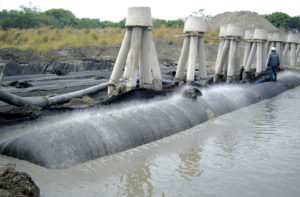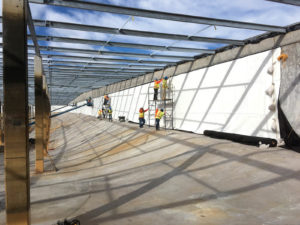The Industrial Fabrics Association International (IFAI) International Achievement Awards (IAA) are an annual competition promoting awareness of the specialty fabrics used in thousands of products and applications ranging in size and shape. For more than 70 years, the awards have recognized innovation, technical skill and design excellence. Entries are judged by industry experts, editors, architects, educators and design professionals who were selected for their knowledge in a particular field of study or product area.
The association presented the awards in the Geosynthetics Products competition at IFAI Expo in New Orleans, La., in late September 2017. Categories included Roadways/Infrastructure, Mines/Landfills/Wastewater and Geosynthetics Miscellaneous.
This issue of Geosynthetics features the winners in the Geosynthetics Miscellaneous category. The magazine will focus on the winners in the Mines/Landfills/Wastewater category in a future issue, and Geosynthetics published the winners in the Roadways/Infrastructure category in the October/November 2017 issue.

IAA Award of Excellence
The use of geosynthetics to protect the highland beach of the Zhuoshui River
Completion Date: Nov. 30, 2016
Fabric Name: ACETube®, ACETex®, ACEFormer and Gabion
Fabric Producer: ACE Geosynthetics Inc.
Fabric Supplier: ACE Geosynthetics Inc.
This project is in central Taiwan, downstream of the floodplain of the Zhuoshui River. The high flow period is from May to October; therefore, its defense flood levels are up to 31,391 yards3/s (24,000 m3/s). The annual rainfall in the mountain catchment area reaches 79 to 118 inches (2,000–3,000 mm). Therefore, this phenomenon is prone to erosion resulting in the loss of the highland beach.
This project required the use of ACETube (geotextile tube) to carry out the protection of the floodplain slope and provide sheltering measures at the bottom of the spur dam. Moreover, ACEFormer (geotextile mattress) was used to strengthen the surface of the slope and to enhance riverbank protection, disaster prevention and mitigation effects.
The repair work is located in the dam section of the riverbank, about 3.1 miles (5 km) from the outlet of the Zhuoshui River; therefore, the floodplain of the riverbank is comprised of river sediment, which is hard for the floodplain to resist river erosion effects that cause the shrinkage of the floodplain, seriously threatening the stability of the river’s dike and local residents’ property and personal safety.
The spur dam was used for riverbank protection. But long-term foundation erosion of the spur head caused loss of soil and its local settlement. Erosion also caused the destruction of the gabion structure, exposing the pierhead. Therefore, immediate repairs were required on these features to ensure the safety of the spur dam.
Since the site was mostly based of silts without any gravel found, project managers decided to use local materials to fill in the ACETube, to help achieve carbon reduction and to reduce the project’s impact on the ecological environment of the river.
The spur dam was installed with polycarbonate hollow pile and polycarbonate hollow crossbeams. First, a layer of polypropylene geotextile was paved on the bottom of both sides of the dam side to slow down base subsidence. Second, ACETube was filled with 2.5 feet or 4.6 feet (0.75 m or 1.4 m) filled height, depending on each spur dam’s exposed situation. They also could be stacked to stabilize the foundation of the pile head and achieve the reinforcement effect. ACETube can prevent partial scouring, increase the security and anti-erosion effects for the group of pierheads, increase the slow flow area, and improve the effectiveness of siltation. Also, in the most intense erosion areas, some gabions were placed on top of ACETube while filling the gaps in between with local sand to enhance the overall resistance to erosion.
On the slope of the floodplain, according to the job site condition, two layers of ACETube were placed with 82 feet or 164 feet (25 m or 50 m) of length and 5 feet (1.5 m) filled height. On top of the layers of ACETube, ACEFormer was placed. Filled with cement mortar, ACEFormer could not only protect the geotextile tubes’ structure, but also increase the whole slope strength.
From 2011 until fall 2016, this project was carried out on more than 3,609 linear feet (1,100 m) for the protection of floodplain slopes and many sets of spur dams along this river. The method of using gabions and placing them on top of geotextile tubes instead of solely using gabions can reduce the cost by around 30%–40%. It not only reduces carbon emission by approximately 88%, but also emphasizes the benefits of geosynthetics for green engineering. After the remediation, the shoreline is extended, and direct erosion of the floodplain is reduced, improving the safety of the riverbank and embankment.

IAA Outstanding Achievement Award
Tucson Water Clearwell Rehabilitation and Replacement Project
Completion Date: March 31, 2017
Fabric Name: CSPE-R 45 mil
Fabric Producer: Burke Industries
Fabric Supplier: Burke Industries
Fabric Name: Geotextile
Fabric Producer: TenCate Geosynthetics
Fabric Supplier: TenCate Geosynthetics
This substantial rehabilitation of the Tucson, Ariz., water delivery system included the liner system removal and installation of a new liner system, roof replacement and many other elements.
The liner system installation required a synthetic rubber liner for the first of two cells, totaling 207,000 square feet (19,231 m2) inside Tucson’s Clearwell Reservoir. The new liner system was built out of custom-fabricated panels to fit between the columns and was specified to be a white 45-mil CSPE-R liner, with 8-ounce nonwoven geotexile underlayment for protection and drainage. It also included a new liner installed over the entire reservoir surface, which included a 14-foot-8-inch (4.5-m) wide panel hung on a 13-foot (4-m) high vertical wall section that was 1,683 feet (513 m) long.
The project also required mechanical attachment of the liner around 143 support columns and multiple other structures.
The general contractor, Colorado Lining International (today part of Raven Industries), specified draining and plugging the reservoir, deck (roof) removal of the entire cell, removal of girder over columns, sandblasting acrylonitrile butadiene styrene (ABS) at the top of the columns along the center wall down to clean metal, X-bracing and new deck roofing along with piping and valve work, as required, to retrofit the reservoir for another 30 years of service.
The reservoir is Tucson Water’s largest potable water storage facility, which consists of two equal-sized cells, holding 30 million gallons (114 million L) each. CSPE-R material was chosen as the best lining system due to the product’s excellent resistance to chlorinated water, outstanding puncture resistance, and good combination of welded seams and adhesive patching on all T-joints and cross seams. The material is also flexible enough to be fabricated into larger panels built to engineered tolerances to fit between the columns properly and limit the amount of field welding required.
The cell had 143 vertical columns, which required attaching a liner using 316 stainless steel battens fastened around each column. Special care and attachment processes were also required for the stairs, inlet and outlets, as well as all the bends and turns that required proper patching and sealing for all corners. This was done in conjunction with a fluid-applied coating at all locations in combination with the mechanical attachment. Total mechanical attachment for the project included 6,608 linear feet (2,014 m) and 13,216 ½” × 4″ anchor bolts drilled and epoxy set to hold the 316 ¼” × 2″ stainless steel batten material to the concrete and create a watertight seal.
Crews were trained to use harnesses and repel equipment for access to areas only reachable via the dam face. Crews also needed to pay special attention to not damage any rebar or structural elements on the dam side of the reservoir when drilling holes for setting the mechanical attachment. Use of special equipment was necessary during this part of the job to make sure crews were penetrating and hitting bolt depth, and at the same time continuing to be cautious to not harm structural components.
The project required two separate layers of liner material sharing a common mechanical bar attachment to prevent the liner material from sliding down the slope and pulling the vertical wall sections away from the wall. It required a layer of butyl tape between each layer of material (two layers total), and the flap created by the second layer was welded down around the perimeter.
The project passed all testing requirements for potable water storage and was delivered on time with no leaks. The reservoir will now be in service for decades to come. Phase 2 began in the fall of 2017 and will finish in late spring 2018, with the same team of contractors on board.
 TEXTILES.ORG
TEXTILES.ORG


